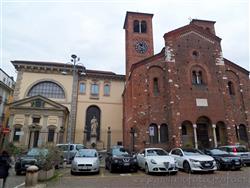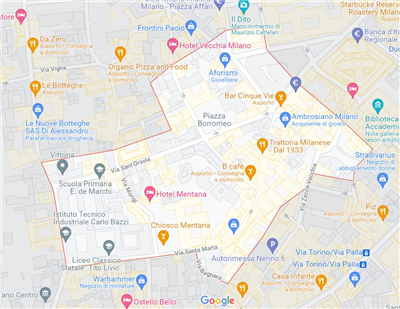|
Five streets
|
|
|
Show an other treasure of art and history in Milan:
|
 Mostly represented styles: 0 Mostly represented styles: 0
The five streets are not a real quarter, but they correspond more generically to the part of the center of Milan around a small square (which seems existed already in Roman times) into which five streets converge: Bocchetto street, del Bollo street, Santa Marta street, Santa Maria Podone street and Santa Maria Fulcorina street.
In each of these streets it is possible to find things of historical and artistic interest, as well as, generically, prestigious buildings, often with rich portals, and interesting details related to the history of Milan.
It should be noted that the square has a hole (which will perhaps be filled in the near future), as one of the buildings that overlook it was destroyed during the Second World War and to date nothing has been built in its place yet.
- Santa Maria Podone street: It is a very short street, which as such does not contain much. However, it leads to Borrommeo Square, overlooked by the Church of Santa Maria Podone (Fig. 7) and Borromeo Palace (Fig. 8).
The Church of Santa Maria Podone is one of the oldest churches in Milan, as it was consecrated in 871. However, it has undergone many changes over the centuries. Between 1440 and 1445 it was renovated in Gothic style and the square in front of it was created. The right lateral chapel, known as the Borromeo chapel, was also added. The bell tower is from the sixteenth century. The façade is Baroque and was built between 1628 and 1643. The four-column porch is instead neoclassical. The interior is divided into three apsed naves and the Baroque elements prevail. There are three side chapels, one on the left, first Borromeo chapel and today chapel of the Holy Family, two on the right, one dedicated to the Crucifix (originally dedicated to Santa Faustina) and a smaller one dedicated to the Virgin of Childbirth. Among the various decorations, the frescoes of the fifteenth century in the apse of the left apse, depicting the coronation of the Virgin and of the Crucifixion of Jesus, are particularly noteworthy.
Note, on the façade, the coat of arms of the Borromeo family inside the tympanum and, in the lunette of the portal, a sculpture of 1483 depicting the Virgin and Child between Vitaliano and Giovanni Borromeo.
Borromeo Palace is a historic building that occupies almost an entire block and constitutes a very important example of a private residence from the Gothic period. Its oldest parts are from the late fourteenth century. The palace has always belonged to the Borromeo family, an important Milanese family of merchants. The palace, which retains its original late Gothic imprint in many of its parts, was severely damaged during the Second World War. The facade is centered on the portal of the early fifteenth century, the pointed arch of which is made up of three frames. The innermost one appears as an alternation of white Candoglia marble and red Verona marble ashlars. The two outer frames are in white marble with plant-themed reliefs. On the cusp of the arch there is a crowned dromedary, one of the heraldic emblems of the Borromeo family. The palace includes two courtyards, of which the rear one is the largest and serves as courtyard of honor. Traces of frescoes depicting the heraldic motifs of the Borromeo family are still recognizable on the walls of the courtyards. The walls of an architectural studio housed in the building (which today is used as offices and homes) still have an entire cycle of frescoes dedicated to the games and pastimes of the Borromeo (ball, tarot, etc ...).
- Santa Maria Fulcorina street: The first interesting thing to find when taking this street is what remains of the Church of Santa Maria Fulcorina (Fig. 1), a church of very ancient origin but demolished and rebuilt in 1734 and then desecrated in May 20, 1798. It was then partially demolished in 1809 and finally completely demolished more than a century later to make room for the passage leading to degli Affari Square. Above the portal there is a fifteenth-century tabernacle from the school of Jacopino da Tradate (Virgin enthroned with Child), heavily corroded by atmospheric agents.
To the right of these remains is an Art Nouveau building (Fig. 2) on the facade of which there is a plaque indicating that in that place there was once the house where Ludovico Antonio Muratori, Italian presbyter, historian, writer, numismatist, diplomatist and librarian, lived during his stay in Milan between 1695 and 1700.
Almost at half of its length, the street forks and taking the branch that goes to the right, you immediately arrive in Affari square (Fig. 3), whith the Mezzanotte Palace in which is the Milan stock exchange. The building, the project of which is due to Paolo Mezzanotte, was built between 1929 and 1932. The facade of the building, in pure twentieth century style, is monumental, 36 meters high and rests on a one meter and a half high entrance staircase. The hall where trading originally took place is now a large congress hall.The palace stands on a part of the area once occupied by the Roman circus. In some points of the internal floor, glass plates have been placed to allow the remains of the Roman era to be admired.
In front of the building there is since 2010 a controversial sculpture by Maurizio Cattelan, entitled L.O.V.E. but commonly known as The Finger.
At the 20th there is the Church of San Matteo alla Banchetta (Fig. 4), a small church of very ancient origins (the first version was built shortly after the middle of the eleventh century). The current building was erected in the eighteenth century. Note the beautiful entrance portal on the exposed brick façade in baroque style. On the left rises the bell tower, while on the right of the church extends Fagnani Palace, of which the church has always been the private chapel. The building, also with an exposed brick facade. The palace is characterized by the portal surmounted by a wrought iron balcony.
To the left of the Church of San Matteo alla Banchetta you can admire House Tonolli (Fig. 5), built in 1921 in Art Deco style.
Santa Maria Fulcorina street, before entering Meravigli street, turns into Santa Maria alla Porta street. The street takes its name from the Church of Santa Maria della Porta, a church built in 1652 during the Spanish domination on a project by the architect Francesco Maria Richini. The style is therefore baroque, but more in the decorations than in the general structure, which is actually very classic and linear. The façade, in particular, is still very reminiscent of the façades of the Counter-Reformation period, although the colossal columns, the greater richness of decorations and the presence of some curvilinear elements reveal the transition to the Baroque style.
The church is famous for the presence on its right side of the remains of a chapel containing an image of the Virgin believed to be miraculous (Fig. 6). The chapel was destroyed by the bombings of the Second World War, but the fresco was not damaged and is now located on what has become the outer wall of the church.
- Del Bollo street: The street owes its name to the fact that it housed the historic post office. Note that it ends in Zecca Vecchia ("Old Mint") street, where the state mint was located.
At the end of del Bollo street, taking the opposite direction to della Zecca Vecchia street, you enter San Sepolcro square. On this square overlooks the Church of San Sepolcro (larger picture). It is a very old church, built in the 12th century in Romanesque style, in place of an earlier one from the 11th century. In the seventeenth century it was renovated in the Baroque style, the style currently predominant inside.
In the wake of the fashion then in vogue, at the end of the nineteenth century, however, the Baroque facade was replaced with a neo-Romanesque one.
The Church of San Sepolcro is located within the complex of the Ambrosian Library, which includes the library, the academy and the art gallery. In front of the wing of the Ambrosian Library overlooking the square to the left of the Church of San Sepolcro there is a statue of Cardinal Federico Borromeo erected in 1864.
Opposite the Church of San Sepolcro is Palazzo Castani, a Renaissance palace whose façade was completely redone in the seventeenth century in Baroque style. Only the portal remains of the previous facade. Today the building is the seat of the Center Commissariat of the State Police. The palace became famous for having been the headquarters of the Milanese Fasci Federation.
The square is also famous for the fact that in it Benito Mussolini gave the speech that marked the birth of fascism in 1919.
- Santa Marta street: Of the five streets it is the longest, although very narrow. It is overlooked by historic buildings and houses of various sizes and opulence and it is full of shops and boutiques. At number 18 there is the historic headquarters of the Society for the encouragement of arts and crafts (Fig. 9), an institution founded in 1838 by exponents of the cultural and economic circles of Lombardy close to the chamber of commerce with the aim of supporting the technical skills of the staff of the factories in that period in strong growth. The portal can be recognized by the wrought iron lunette and the inscription in relief.
If you are interested in a guided tour of this monument send an email!
Categories: Interesting details, villages of
Cinque Vie, 20123 Milano MI |
Further pictures of the Five streets in the section Photography |